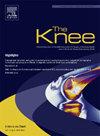小胫骨后坡角≤70 (PTS角)对离体PCL重建的预后有负面影响:PTS≤70与> 70度的比较分析。
IF 1.6
4区 医学
Q3 ORTHOPEDICS
引用次数: 0
摘要
目的:了解孤立性后十字韧带(PCL)撕裂患者胫骨后斜(PTS)分布的发生率,以及PTS对PCL重建(PCL- r)后影像学、临床和功能结局的影响。方法:63例有症状的孤立性pcl撕裂行PCL-R的患者,根据pts -角度以70度为临界值分为a组(小于≤70度)和b组(大于70度)。所有的病人都采用了同样的方法。比较pts角度对6个月和1年的放射学预后(胫骨后平移(PTT))的影响。比较两组6个月、1年和最后随访时的临床结果(膝关节活动度(ROM)、股四头肌萎缩(QW))和功能结果(IKDC和Tegner-Lysholm评分)。结果:66.7%的患者PTS <≤70度。平均pts角为6.47±2.40°。放射学上,6个月时PTT无统计学差异。1年时,a组PTT(3.98±2.21 mm)小于b组(3.03±1.42 mm) (P = 0.04)。a组2例患者6个月时PTT为iii级,1年时PTT为iii级。平均随访时,a组IKDC和Tegner-Lysholm(81.55±11.4,90.19±5.53)低于b组(86.56±7.2,94.6±4.42),差异有统计学意义(IKDC:P = 0.038, Tegner-Lysholm:P = 0.001)。在1年和平均随访时,a组的ROM显著降低(p = 0.047)。6个月和1年的QW无显著差异。结论:术前PTS角度较低(≤70)对孤立性PCL-R的预后有负面影响,且与PTS角度较高(bbb70)的患者相比,会导致继发性膝关节后侧松弛。胫骨后小斜度(≤70)在孤立性PCL损伤中的发生率为66.7%。本文章由计算机程序翻译,如有差异,请以英文原文为准。
Lesser posterior tibial slope angle ≤70 (PTS-Angle) has negative effect on outcome of isolated PCL reconstruction: Comparative analysis of PTS ≤70 vs > 70 degrees
Purpose
To determine incidence of posterior-tibial-slope (PTS) distribution in patients with isolated posterior-cruciate-ligament (PCL) tear, as-well-as the effect of PTS on radiological, clinical, and functional outcomes after PCL-reconstruction (PCL-R).
Methods
63 patients with symptomatic isolated PCL-tears who underwent PCL-R were divided into two groups based on a PTS-angle with a cut-off value of 70-degrees: group-A (less than ≤70-degree) and group-B (more than >70-degree). All the patients were subjected to the same technique. The effect of PTS-angle on the radiological-outcome, (posterior-tibial-translation (PTT)) at 6-month and 1-year intervals was compared. Clinical-outcomes (knee range-of-motion (ROM), quadriceps-wasting (QW)), and functional outcomes (IKDC and Tegner-Lysholm scores) at 6-month, 1-year, and final follow-up was compared between the groups.
Results
PTS of less than ≤70-degrees was seen in 66.7%. The mean-PTS-angle was 6.47 ± 2.40degrees. Radiologically, there was no statistical-difference in PTT at 6-months. However, at 1-year, PTT was less in group-A (3.98 ± 2.21 mm) than in group-B (3.03 ± 1.42 mm) (P = 0.04). Two patients in group-A had grade-III PTT at 6-months, and one of them had grade-III PTT at 1-year. At the mean-follow-up, group-A had lower IKDC and Tegner-Lysholm (81.55 ± 11.4, 90.19 ± 5.53) than group-B (86.56 ± 7.2, 94.6 ± 4.42), indicating a statistically significant difference (IKDC:P = 0.038, Tegner-Lysholm:P = 0.001). At 1-year and mean-follow-up, group-A had a significantly lower ROM(p = 0.047). There was no significant difference for QW at 6-months and 1-year.
Conclusion
Lesser preoperative PTS angle (≤70) has a negative effect on the outcome of isolated PCL-R and leads to secondary posterior knee laxity than in patients with higher PTS angle (>70). Incidence of lesser posterior tibial slope (≤70) in isolated PCL injuries is 66.7%.
求助全文
通过发布文献求助,成功后即可免费获取论文全文。
去求助
来源期刊

Knee
医学-外科
CiteScore
3.80
自引率
5.30%
发文量
171
审稿时长
6 months
期刊介绍:
The Knee is an international journal publishing studies on the clinical treatment and fundamental biomechanical characteristics of this joint. The aim of the journal is to provide a vehicle relevant to surgeons, biomedical engineers, imaging specialists, materials scientists, rehabilitation personnel and all those with an interest in the knee.
The topics covered include, but are not limited to:
• Anatomy, physiology, morphology and biochemistry;
• Biomechanical studies;
• Advances in the development of prosthetic, orthotic and augmentation devices;
• Imaging and diagnostic techniques;
• Pathology;
• Trauma;
• Surgery;
• Rehabilitation.
 求助内容:
求助内容: 应助结果提醒方式:
应助结果提醒方式:


